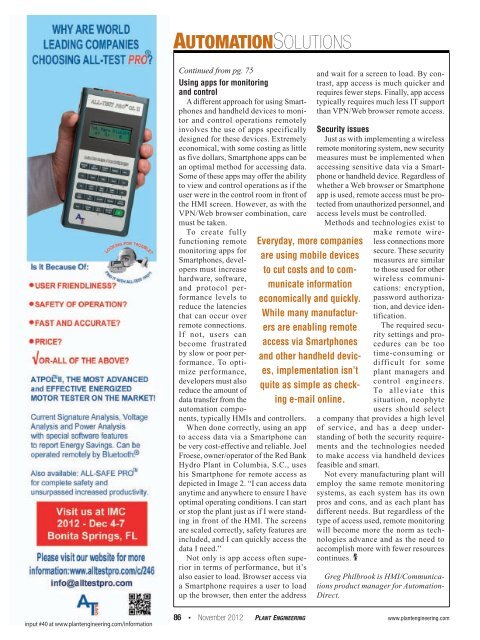2012 - PageSuite
2012 - PageSuite
2012 - PageSuite
Create successful ePaper yourself
Turn your PDF publications into a flip-book with our unique Google optimized e-Paper software.
aUTOMaTIONSOLUTIONS<br />
Continued from pg. 75<br />
Using apps for monitoring<br />
and control<br />
A different approach for using Smartphones<br />
and handheld devices to monitor<br />
and control operations remotely<br />
involves the use of apps specifically<br />
designed for these devices. Extremely<br />
economical, with some costing as little<br />
as five dollars, Smartphone apps can be<br />
an optimal method for accessing data.<br />
Some of these apps may offer the ability<br />
to view and control operations as if the<br />
user were in the control room in front of<br />
the HMI screen. However, as with the<br />
VPN/Web browser combination, care<br />
must be taken.<br />
To create fully<br />
functioning remote<br />
monitoring apps for<br />
Smartphones, developers<br />
must increase<br />
hardware, software,<br />
and protocol performance<br />
levels to<br />
reduce the latencies<br />
that can occur over<br />
remote connections.<br />
If not, users can<br />
become frustrated<br />
by slow or poor performance.<br />
To optimize<br />
performance,<br />
developers must also<br />
reduce the amount of<br />
data transfer from the<br />
automation components,<br />
typically HMIs and controllers.<br />
When done correctly, using an app<br />
to access data via a Smartphone can<br />
be very cost-effective and reliable. Joel<br />
Froese, owner/operator of the Red Bank<br />
Hydro Plant in Columbia, S.C., uses<br />
his Smartphone for remote access as<br />
depicted in Image 2. “I can access data<br />
anytime and anywhere to ensure I have<br />
optimal operating conditions. I can start<br />
or stop the plant just as if I were standing<br />
in front of the HMI. The screens<br />
are scaled correctly, safety features are<br />
included, and I can quickly access the<br />
data I need.”<br />
Not only is app access often superior<br />
in terms of performance, but it’s<br />
also easier to load. Browser access via<br />
a Smartphone requires a user to load<br />
up the browser, then enter the address<br />
Everyday, more companies<br />
are using mobile devices<br />
to cut costs and to communicate<br />
information<br />
economically and quickly.<br />
While many manufacturers<br />
are enabling remote<br />
access via Smartphones<br />
and other handheld devices,<br />
implementation isn’t<br />
quite as simple as checking<br />
e-mail online.<br />
and wait for a screen to load. By contrast,<br />
app access is much quicker and<br />
requires fewer steps. Finally, app access<br />
typically requires much less IT support<br />
than VPN/Web browser remote access.<br />
Security issues<br />
Just as with implementing a wireless<br />
remote monitoring system, new security<br />
measures must be implemented when<br />
accessing sensitive data via a Smartphone<br />
or handheld device. Regardless of<br />
whether a Web browser or Smartphone<br />
app is used, remote access must be protected<br />
from unauthorized personnel, and<br />
access levels must be controlled.<br />
Methods and technologies exist to<br />
make remote wireless<br />
connections more<br />
secure. These security<br />
measures are similar<br />
to those used for other<br />
wireless communications:<br />
encryption,<br />
password authorization,<br />
and device identification.<br />
The required security<br />
settings and procedures<br />
can be too<br />
time-consuming or<br />
difficult for some<br />
plant managers and<br />
control engineers.<br />
To alleviate this<br />
situation, neophyte<br />
users should select<br />
a company that provides a high level<br />
of service, and has a deep understanding<br />
of both the security requirements<br />
and the technologies needed<br />
to make access via handheld devices<br />
feasible and smart.<br />
Not every manufacturing plant will<br />
employ the same remote monitoring<br />
systems, as each system has its own<br />
pros and cons, and as each plant has<br />
different needs. But regardless of the<br />
type of access used, remote monitoring<br />
will become more the norm as technologies<br />
advance and as the need to<br />
accomplish more with fewer resources<br />
continues. P E<br />
Greg Philbrook is HMI/Communications<br />
product manager for Automation-<br />
Direct.<br />
input #40 at www.plantengineering.com/information<br />
86 • November <strong>2012</strong> plant engineering www.plantengineering.com

















